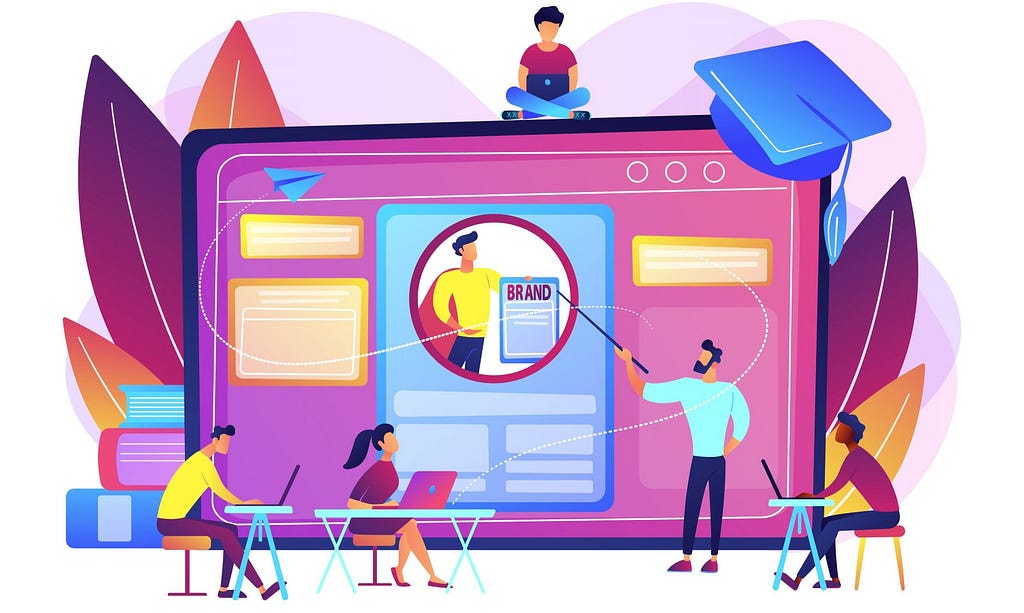Rather than solely focusing on product characteristics and features, an authentic and creative narrative can convey brand values and connect with the target audience in a more strategic way.
We are all the heroes of our own stories, and building a narrative around our experiences courses in our veins. Binging on stories is one of our most common and universal tendencies, as it helps us better understand the world and ourselves, apart from offering us an invitation to dive into another reality.
What once started around campfires and on the walls of caves has evolved into a powerful method of connection in modern life, as well. Nowadays, stories are also being crafted around businesses as a powerful tool in branding and marketing, tapping into our shared nature.
With increased competition in the digital marketplace, you may find that the old art of storytelling and content offers you (a statistically proven) edge over your rivals. Research confirms that “a significant amount of potential revenue is lost globally due to poor online customer experiences”. Yet, where the competitor is only one click away, this is still one pitfall you can easily avoid.

Onwards and upwards
Earlier this year, Statista forecasted that SaaS as an industry is expected to rise to $208 billion by 2023. This is a pretty neat jump from the 2021 estimates of $152 billion, and even more impressive when you consider that in 2015 the same spending was gauged to be at £31 billion.
It is predicted that the US will hold onto its №1 spot as the world’s largest SaaS market with currently over 17,000 companies. Compared to the runners-up Canada as well as the UK rivalling with 2000 each only, this means that the US boasts over a whopping 8 times more SaaS companies than any other country.
The data speaks for itself: it’s a good time to get into the playing field from whatever angle you can approach the game. Nonetheless, the competition only builds pressure around having to stand out in order to gain your slice of the pie.
So, what if I told you that storytelling has an indirect long-term impact and very much drives conversion rates and ROI?

What’s your story?
Though the value of creative copy often goes unnoticed or intentionally kicked to the curb for a later time, you may well be shooting yourself in the foot, if you go with this herd. Ever feeling like you’re limping behind? Now you have an idea why.
Research by creative agency Headstream showed that 79% of people want to hear brands telling stories. Hence, stepping away from merely plugging your product’s technicalities and features in order to craft a more captivating narrative is an approach in high demand.
If you want to engage and interact with your customers, whilst also fostering interest in your brand, you need to introduce yourself by means of quality content, not just a data-driven sales pitch.
You know how much I love my data, research, and anything statistical. Whilst these are superb starting points to gauge your audience, trends, and current interests, these alone are not enough for building your business. If you want to perform better than your competitors, it’s time to get creative. Literally.
Still based on Headstream’s findings, if people really love a brand’s story, over half (55%) are likelier to buy the product in the future. At the same time, 44% will share the story and 15% will buy the product immediately. Need I say more? Actually, I do.

Content = Advantage
Company narratives are stored in memory factually, visually, and emotionally, lodging them in the consumer’s mind on multiple levels. This then bears the possibility of positively affecting brand perception, which in turn, once again, means boosting the chance for increased sales conversions.
A creative and authentic story builds a personal connection, partially due to human memory being story-based. These narratives construct a mental representation of brands, planting them in long-term memory and even increasing advertising efficiency. Whilst fostering an emotional investment through engaging your audience, you provide meaning and shape attitudes towards your product.
To add, companies that invest in online content and blogging generate an average of 67% more leads per month and get 55% more website visitors than those who don’t.
Naturally, all this also helps with your SEO ranking and visibility.
Your story can ultimately either be bordering on non-existent or giving you a competitive advantage, serving in multi-faceted ways if only you pay it some heed. So, what’s it gonna be?
Breathing life into brand, product and UX
Hopefully, by now I have made a solid enough case for the usefulness and necessity of storytelling in the current digital era. Still, if you require some further nudges, read on for a list of general research-based conclusions and summaries:
➤ Stories provide meaning to brands and help customers understand their values and what the business represents. In a world where 64% of people prefer buying from companies with a reputation for having a purpose, this adds up to a significant impact on your customer base. Product benefits can also be communicated in a more easily understandable way through well-crafted narratives.
➤ Research has shown that captivating stories can move audiences towards action, whereas “lecturing” them about your product evokes argumentative thinking. The more you invite the latter, the less likely your pitch will result in a reflexive click on your sign-up (or purchase) CTA button.

➤ Learning via storytelling is a more effective way to anchor your brand in your customers’ subconscious. Feeling keen on pushing out your competitors from their minds? You might want to take up some of their cognitive bandwidth for that.
➤ Storytelling can be used to explain complex concepts or processes, making them easier for users to understand products and specific aspects. According to Pendo, 80% of software features rarely or never get used. Their calculations estimated that this translated into a $29.5 billion loss in 2018. Highlighting features in a more creative form could help users discover and adopt them more easily, resulting in a better outcome for all parties.
➤ Users’ experience with digital interfaces not only affects their perception of the product’s quality but also the entity behind it. In other words, branding and interaction are closely linked to one another. Positive flow also significantly adds to an audience’s trust in a brand, which then leads to customer loyalty.
UX Writing, is that you?
Yes and no.
Microcopy clearly still feeds into a brand as a whole, but brevity might not serve you well by itself. Opting for only shorter snippets when endowing a business with personality and narrative could choke the life out of it entirely.
Learning how to balance content writing and product marketing alongside microcopy will equip you with a telling and rich leverage. Being able to weave a narrative under varying length constraints is not an easy task, but different outlets lend themselves to novel approaches.
Short and long forms of copywriting both have the potential to convert users.
Concise text works better when tailoring content to word or character count, or when it is more effective to get to the point without wordy bells and whistles. Longer forms can answer more questions and present a coherent narrative from the start. Both have a place in a brand’s storytelling strategy and should be applied to the context.

You snooze, you lose
To quote Seth Godin,“marketing is no longer about the stuff that you make, but about the stories you tell.” If you truly care about putting your product out there, wrapping it up in an engaging narrative and emotional substance should ideally be at the back of your mind at all times.
If you don’t capitalise on your audience’s need for creative interaction, your competitors will.
Thanks for reading! ❤️
If you liked this post, follow me on Medium for more!
References & Credits
- Public cloud application services/software as a service (SaaS) end-user spending worldwide from 2015 to 2023 by Statista
- Saas Database by Latka
- Meaningful Brands 2021 Report by Havas Group
- The 2019 Feature Adoption Report by Pendo
- Bilgihan, A. (2016). Gen Y customer loyalty in online shopping: An integrated model of trust, user experience and branding. Computers in Human Behavior, 61, 103–113.
- Bilgihan, A., Kandampully, J., & Zhang, T. C. (2016). Towards a unified customer experience in online shopping environments: Antecedents and outcomes. International Journal of Quality and Service Sciences.
- Fog, K., Budtz, C., & Yakaboylu, B. (2005). Storytelling. Berlin: Springer.
- Karampournioti, E., & Wiedmann, K. P. (2021). Storytelling in online shops: the impacts on explicit and implicit user experience, brand perceptions and behavioral intention. Internet Research.
- Mileski, D., Schneider, F., & Bruegge, B. (2015, July). Visual storytelling. In Proceedings of the 18th European Conference on Pattern Languages of Program (pp. 1–7).
- Schank, R. C. (1999). Dynamic memory revisited. Cambridge University Press.
- Singh, S., & Sonnenburg, S. (2012). Brand performances in social media. Journal of interactive marketing, 26(4), 189–197.
- Woodside, A. G., Sood, S., & Miller, K. E. (2008). When consumers and brands talk: Storytelling theory and research in psychology and marketing. Psychology & Marketing, 25(2), 97–145.
- Woodside, A. G. (2010). Brand‐consumer storytelling theory and research: Introduction to a Psychology & Marketing special issue. Psychology & Marketing, 27(6), 531–540.
- Yang, T., & Bolchini, D. (2014). Branded interactions: Predicting perceived product traits and user image from interface consistency and visual guidance. Interacting with Computers, 26(5), 465–487.
- Ben Youssef, K., Leicht, T., & Marongiu, L. (2019). Storytelling in the context of destination marketing: An analysis of conceptualisations and impact measurement. Journal of Strategic Marketing, 27(8), 696–713.
- Images by vectorjuice on Freepik
Storytelling as a service in SaaS was originally published in UX Collective on Medium, where people are continuing the conversation by highlighting and responding to this story.